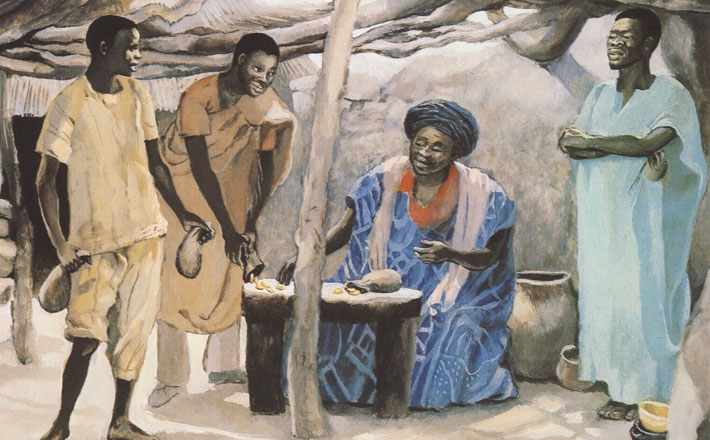Commentary on 1 Thessalonians 5:1-11
It is commonplace for biblical scholars and others to critique the apocalyptic worldview as dualistic, and it is certainly wise to be on guard against habits of thought that pit one group of people against another in a stereotypical fashion.
But in order to understand the apocalypticism that pervades the New Testament, including the preaching of Jesus, it is equally important to pay attention to the possible social context to which dualism was a response. Perhaps the problem Paul is addressing is a situation in which certain members of the Thessalonian assembly are failing to make distinctions between their ethical codes as people of God and the actions of the general society around them. They may not fully understand that the ekklesia is not just another social club, but a radically counter-cultural way of life, grounded in the cross of Christ.
The contrasts are certainly sharply drawn in 1 Thessalonians 5:1-11: light vs. darkness, day vs. night, wakefulness vs. sleep, sobriety vs. drunkenness, urgency vs. a lack of urgency. Much of the vivid imagery in the passage (the thief in the night, the woman in labor, the armor of God) is drawn from the prophets (Isaiah, Jeremiah, Joel), and is echoed in other New Testament texts as well as documents from Qumran. Such prophetic speech was felt to have divine power to alter people’s interpretation of current events and their moral responses to it. It actually seeks to change what people see as they look around them, and how they respond to it.
Urgency
The urgency of the “day of the Lord” (1 Thessalonians 5:2; and suggested also by “the times and the seasons,” chronos and kairos, 5:1) is actually moral urgency expressed as chronological urgency. The entry of God (the day of the Lord, the parousia) is inevitable, like labor pains, but indefinite, like the arrival of a thief in the night. Thus, the people of God must be prepared at all times, like dutiful guards on watch.
The power of holiness
Many people in my congregation are leery of the image of God as judge that runs through this passage. And given the judgmentalism that can go with religious fervor, they are right to be wary. But passages like this one witness not to God’s specific decision to come in judgment, but to a deep-seated Jewish intuition of the awesome and terrifying power of sheer holiness.
For example, the reason for the elaborate description of the consecration of priests for the Temple (Leviticus 8) is to stress the means by which they were set apart and prepared to deal with holy things. On the negative side, the strange story of the death of Uzzah after he simply reaches out to steady the ark of the covenant when it is being carried in procession (2 Samuel 5:1-15) is another witness to the potentially destructive power of holiness when someone who is unprepared comes into contact with it.
The day of the Lord (or the parousia) will entail judgment not because God chooses to be judgmental, but simply because the full presence of absolute holiness is destructive to whoever or whatever is unprepared to be in its proximity. This is the theological rationale behind Paul’s concern for holiness of life among the communities he served. He is preparing his communities (sometimes actually likened to the Temple, 1 Corinthians 3:16-17, 6:19; 2 Corinthians 6:16) to be in the presence of pure holiness on the longed-for day, sure to come, when God is all in all.
Holiness at human scale
So what, then, are the characteristics of holiness at human scale? In this particular passage, they consist of the strangely vulnerable armor of God, community practices of encouragement, and the model of “the Lord Jesus Christ, who died for us” (5:9-10).
Children of light
In his theological foundation, Paul has drawn a sharp distinction between “you” and “them,” between the “children of light” and those who are “of the night or of darkness.” Literally he says, “sons of light,” an image that depends for its force on the understanding that the role of sons in Greco-Roman families was to carry on the work of their fathers. Thus, the sons (and daughters) of light carry on the work of God, who is Light. And those who derive their life from darkness carry on the work of darkness.
Being a “son” of light is a reference to what one does, as an outward manifestation of who one is. But in spite of the stark distinctions Paul draws, the armor that the Thessalonians are advised to put on consists of the seemingly-fragile but actually powerful breastplate of faith and love and helmet of hope of salvation (1 Thessalonians 5:8-9). There is a difference here between being discerning toward outsiders (which Paul advocates) and opposing them with force, which he clearly does not endorse.
Mutual encouragement
The action that Paul most explicitly commends is mutual encouragement (consolation), a repeated practical theme of 1 Thessalonians (2:12; 3:2,7; 4:1,10, 18; 5:11,14). What stands out forcibly is that the building-up of community in Christ is, for Paul, evidence of holiness of life. Holiness is not an individual endeavor, but a daily practice of building up the people around us.
Jesus as the moral pattern
Finally, as an image of holiness, Paul puts forward the model of Jesus “who died for us, so that whether we are awake or asleep we may live with him” (1 Thessalonians 5:10). This is an astonishing statement for several reasons. One is the assertion that whether we are awake or asleep we may live with him. Having drawn the distinctions so keenly between sleeping and waking, light and dark, Paul gathers up the whole community of the baptized in this assurance of their salvation.
The other interesting aspect of Paul’s mention of Christ is less explicit, but is a theme he returns to often in his teaching: the cross as a moral pattern (Philippians 2:1-13; and the stunning statement, “I die every day” of 1 Corinthians 15:31). A holy community is one in which the participants are giving themselves away in the small currency of everyday acts for the common good.
Like so much of the teaching of Paul, this final chapter of 1 Thessalonians appears on the surface to be almost incapable of having applicability to 21st century life. But upon closer examination, there are themes that offer both wisdom and appropriate — even urgent — challenge to present-day communities of faith:
- the need for cultural discernment;
- the unlikely power of faith, hope, and love;
- and the importance of community for one’s personal holiness, evidenced in practices of mutual encouragement and care.


November 19, 2017